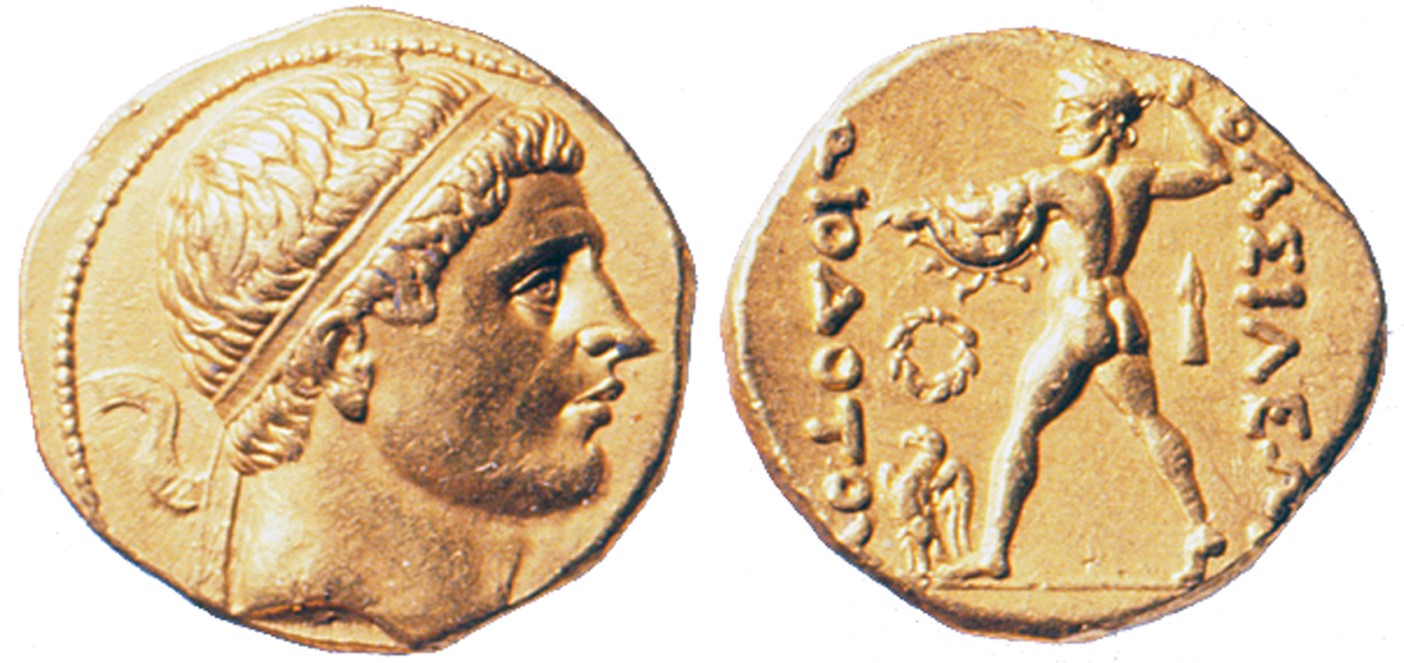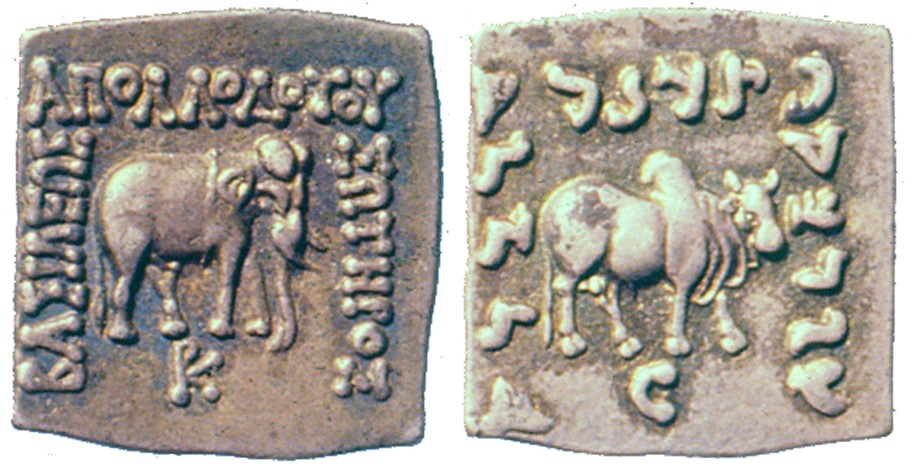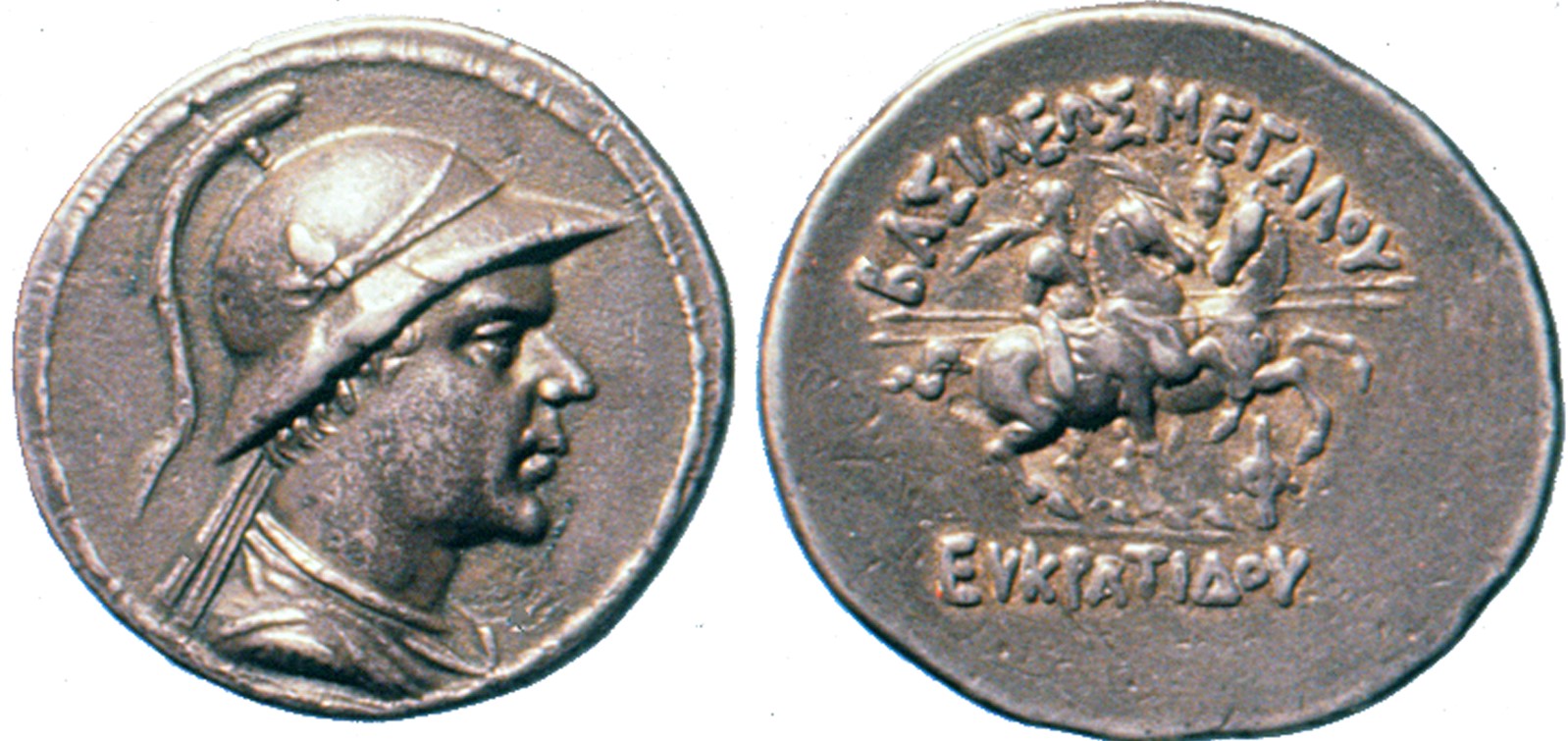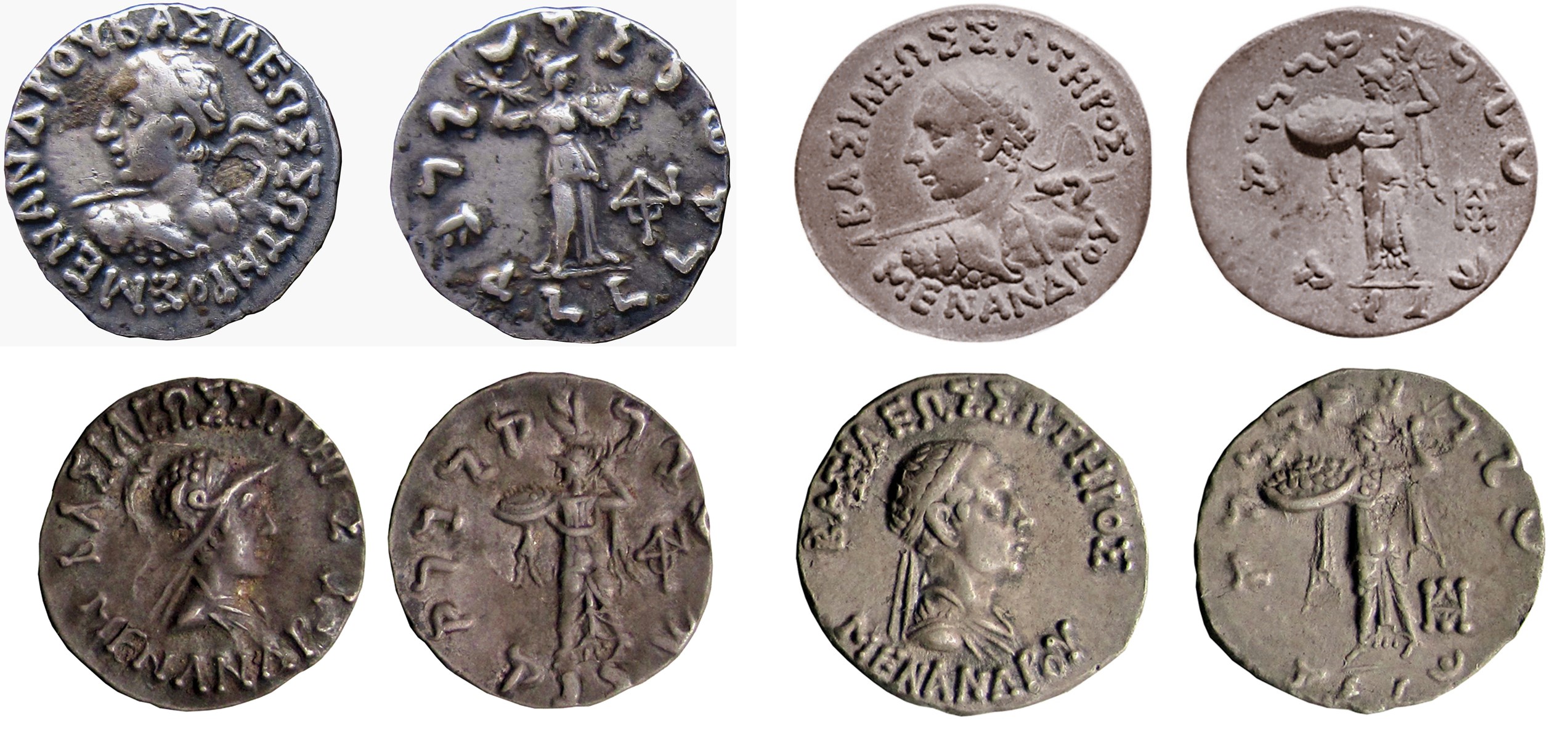The second half of the 3rd century BCE – beginning of the 2nd century BCE witnessed a momentous change in the coinage of Indian sub-continent. This was the beginning of inscription on coins. Coins issued hitherto had only symbols and motifs on them and were without any written letters. This is the reason that attribution of these coins to some states or territories are at best speculative, leaving aside any chance of their attribution to specific rulers. This changed with the appearance of inscription on the coins. Now the coins could be definitely identified and ascribed to states / dynasties and / or even rulers. Amongst the first who started this practice of inscribing coins were the Bactrian-Greek and Indo-Greek rulers. But, who were these Greek rulers? Come, let us find out.
Historical Background
In the 5th-4th centuries BCE, areas in the north-western part of the Indian sub-continent and also to the north of it like Sogdia (around Samarkand), Bactria (northern Afghanistan and the territories on the opposite bank of Oxus river), Aria (north-western Afghanistan, around modern Heart), Arachosia (south-eastern Afghanistan around Kandahar), Drangiana (south-western Afghanistan), Sattagydia (the Kabul region), Gandhara (north-western Pakistan, around Peshawar), and northern Pakistan on the banks of the Indus river had formed part of the Achaemenid or Persian Empire. The Persian rule in this area came to an end with the conquest of these areas by Alexander the Great, the famous Macedonian King, in about 329-326 BCE. Alexander died very young in 323 BCE, and in the years following it, though the Macedonian control seems to have been retained over these areas but the Indus valley was lost soon after. By the close of 4th century BCE the provinces of Parthia, Aria, Bactria and Sogdia passed under the control of the Seleucid dynasty established by Seleucos, the general of Alexander in Syria and Babylonia, but the territories south of the Hindukush were conquered back by the Mauryan king Chandragupta Maurya. The provinces of Bactria and Sogdia were governed by Greek governors on behalf of the Seleucid kings. We learn from the classical sources that around the middle of 3rd century BCE Diodotus, the Greek governor of Bactria, revolted against his Seleucid masters and established an independent kingdom. This was the beginning of a Greek rule in this region.
This newly formed Greek kingdom soon extended its control over the whole of Bactria and Sogdia in the north of Hindukush and is known as Graecko-Bactrian Kingdom. By the beginning of 2nd century BCE, the Greeks had started crossing the Hindukush and extending their territories southwards into the sub-continent. During the early part of 2nd century BCE they first extended their rule into the Kabul area and further to the south and east in north-west Pakistan. The Greeks who ruled south of the Hindukush are generally referred to as Indo-Greek to distinguish them from Bactrian Greeks. These Greek rulers issued perhaps the first inscribed coins and also perhaps the first die-struck coins in India. It is these coins left by the Indo-Bactrian Greek rulers that have largely helped in the reconstruction of their history as the literary and other evidence bearing on their history are rather sketchy.
Graecko-Bactrian Coins
The Bactrian-Greek coins were mono-scriptal having inscriptions written in only Greek script and were issued on the Attic weight standard. The basic design of these coins had the royal portrait on the obverse and a deity and the name and title of the ruler inscribed in Greek on the reverse. This formula of royal portrait / deity was initiated by the Seleucid successors of Alexander, and was continued by the Graecko-Bactrians. But on some coins, particularly the copper ones, the design usually comprised a deity on one side and another or an object or an animal associated with the deity and Greek inscription on the other.
The portraits on the coins of Bactrian-Greek and early Indo-Greek rulers are very realistic. They exude powerful features and show minute personal details (see figs 1-3). They are also very well made - the dies are perfectly centred and the details are in high relief. Although a few rulers like Diodotus, Euthydemus and Eucratides issued coins in gold also in the Bactria region, silver and copper were the main metals in which Indo-Bactrian coins were issued. In the Indian territories, except for a lone uninscribed type of Menander, the Indo-Greeks did not issue any gold coins.

Fig. 1. Diodotus I (c. 250-230 BCE). Gold stater.

Fig. 2. Euthydemos I (c. 230-200 BCE). Silver Tetradrachm. Courtesy: coinindia.com

 Fig. 3. Antimachos I (c. 185-170 BCE). Silver tetradrachm. Courtesy: wildwinds.com
Fig. 3. Antimachos I (c. 185-170 BCE). Silver tetradrachm. Courtesy: wildwinds.com
The classical historians mention Demetrius, son of Euthydemus the king of the Bactrians, and Menander as having played an important role in the conquest of India. And it is generally believed that Demetrius I (c. 200-190 BCE) was the first Bactrian Greek ruler who attempted to extend the Greek territories to the south of the Hindukush. Interestingly, there is an indirect iconographic evidence for this furnished by one of his silver coin types. On this type the king is shown wearing an elephant’s scalp as the headdress (see fig. 4). Elephant is taken as symbolizing India as it is here the Greeks first encountered this animal.

Fig. 4. Demetrios I (c. 200-190 BCE). Silver. Courtesy: Trustees, The British Museum
The First Bilingual Coins with Greek and Brahmi Inscriptions
Interestingly, even before the Greek rule was firmly established in parts of Indianian sub-continent, efforts seem to have been made to find favour with the local pupulation. This is reflected by the study of coins. Around the beginning of 2nd century BCE, two Bactrian-Greek rulers, Agathocles and Pantaleon, who were either contemporaries or close successors, issued for the first time a bilingual copper coinage for the Indian territories. These coins were remarkable in several respects. First, the shape of these coins was changed from the usual round shape of the Bactrian-Greek coins to rectangular to make them appear similar to the local coins. Secondly, in addition to the Greek, the local script Brahmi and local language Prakrit was also adopted for writing the coin legend. Many of you might be aware of the fact that it was these bilingual coins that also helped in the decipherment of the Brahmi script in 19th century. Another important feature of these coins was their indigenous iconography. These coins show a lion standing to right with Greek inscription on one side and a female deity holding a lotus and Brahmi inscription on the other. Some scholars have identified the female deity with Ekanmsa or Subhadra, Krishna’s sister, or Lakshmi. Obviously these changes were attempts by the Greek rulers to gain some sort of acceptability for their coinage and also for themselves in the newly acquired Indian territories.
From the point of view of the use of indigenous iconography, the most remarkable is a bilingual silver coin type of Agathocles (see fig. 5). These coins show Samkarshana-Balarama holding his attributes, a plough and a pestle (musala) with inscription in Greek on one side and Vasudeva-Krishna holding a chakra (wheel) and sankha (conch) with inscription in Brahmi on the other. These are perhaps amongst the earliest representation of these deities.

Fig. 5. Agathocles (c. 190-180 BCE). Silver. Courtesy: INHCRF archives
Coins Issued in Memory of Predecessors
An interesting series of coins, called ‘pedigree’ or ‘commemorative’ coins, were issued Agathocles (c. 190-180 BCE) and Antimachus I (c.185-170 BCE), two Bactrian Greek kings.

Fig. 6. Pedigree coins issued by Agathocles. Courtesy: Trustees, The British Museum
These commemorative coins were issued to proclaim their attachment to and in memory of their predecessors. The ones issued by Agathocles (Fig. 6) depict on the obverse the portraits of Alexander, Antiochus II, Diodotus I and II, Euthydemus I, Demetrius I and Pantaleon while those issued by Antimachus I have the portraits of Diodotus I and Euthydemus I. Eucratides I (c.170-145 BCE) was another ruler who issued a commemorative coin in the memory of his parents. The reverse of this type depicts the portraits of his parents, Heliocles and Laodice.
Beginning of Indo-Greek Coinage
The bilingual coins, discussed above, were not really what are called the ‘Indo-Greek’ coins. The coins that are called Indo-Greek are also bilingual but have inscriptions in Greek and Kharoshti scripts. Besides, these are based on a lighter so-called Indian weight standard unlike the Bactrian Greek coins, which were based on Attic weight standard . It was a king named Apollodotus I (c. 180-170 BCE), immediate successor of Agathocles, Pantaleon and Antimachus I in the Indian territories, who is credited with the introduction of the Indo-Greek coins. After many experiments, he issued a silver drachm (Fig. 7) with elephant and Greek inscription on one side and humped bull and Kharoshti inscription on the other side in place of the usual royal portrait and Greek deity. These coins were struck in square shape and with a weight of about 2.4-2.45 gm. The selection of the shape, motifs, local script and language and the weight were perhaps dictated by the desire to gain acceptability for their coins alongside the silver punchmarked coins which were in use in those areas. This new silver drachm based on a so-called Indian weight standard apparently found acceptability and was followed not only by all the subsequent Indo-Greek rulers but also long after the Greek rule had disappeared from India. The round shape of the coins was restored immediately after Apollodotus I and the royal portraits / divine figures were reintroduced a little later by Menander.

Fig. 7. Apollodotus I (c. 180-160 BCE) silver drachm. Courtesy: Trustees, The British Museum
End of Greek Rule in Bactria
Eucratides I (c. 170-145 BCE) was the last Greek ruler to rule both over Bactria and south of the Hindukush was. He is described by the Roman historian Justin as a usurper who overthrew Demetrius (II) and became a powerful king in Bactria and also invaded India. Eucratides I issued both monolingual (Figure 8) and bilingual coins and in plenty. He is said to have been killed by his own son but who amongst his three successors in Bactria – Eucratides II, Plato and Heliocles who ruled almost concurrently, was this son is not known. In any case, the Yueh-chih, the nomadic tribe from Central Asia, had started overrunning the Greeks from Bactria by the end of Eucratides I’s reign and wiped out the Greeks from there by c. 130 BCE. Heliocles I (c.145-130 BCE) was the last Greek to have ruled there.

Fig. 8. Eucratides I (c. 170-145 BCE). Courtesy: Trustees, The British Museum
Consolidation of the Indo-Greek Rule in India
The real consolidation of the Indo-Greek rule in India took place during the reign of Menander I (c. 155-130 BCE), the most famous Greek ruler to have ruled in India. He appears to have ruled over a wide territory and issued the largest number of coins and coin types both in silver (Fig.9) and copper amongst the Greek rulers. Besides reintroducing the royal portraits and Greek divine figures on the Indo-Greek coins, Menander also introduced the new tetradrachm based on the so-called Indian weight standard.
The Classical authors mention Menander as a conqueror of India and it is said that he had reached as far as the Jamuna river. He is the only Greek king who seems to have been mentioned in Indian literature. The Milinda of Milindapanha (The Questions of King Milinda) is identified with Menander. This work is related to a conversation that supposedly took place between king Milinda, the chief of the Yonaka, and the Buddhist sage Nagasena on the nature of soul, the eightfold path (ashtanga marg), and on the liberation from the cycles of births. In one of the versions of this text, it is said at the end that the king retired from the world and handed over the reins of the kingdom to his son. There is however no evidence to show that Menander gave up his rule.

Fig. 9. Menander I (c. 155-130 BCE). Silver dtachms
End of Indo-Greek Rule
For more than a century after the death of Menander I, parts of the Indo-Greek kingdom remained under the control of the Greek rule. Many Indo-Greek rulers ruled, often concurrently in different regions, during this period. Gradually, however, the Greek rule in India was eroded by three groups of invaders – the Yueh chih, Scythians and Parthains. After driving away the Greeks from Bactria in about 130 BCE, the Yueh-chihs drove them away from Kabul also in about 70 BCE. The Scythians captured Taxila from the Greeks in about 90-80 BCE. Though the Indo-Greeks recovered it back but their rule in Gandhara and western Punjab was completely replaced by the Scythians in c. 55 BCE. Even after this the Greek rule was preserved over a small area in eastern Punjab till about 10 CE until they were finally conquered by the Scythians. Thus the Greek rule in India came to an end.
The impact of the Indo-Greek currency however lasted much longer. Not only did the Indo-Scythians and Indo-Parthians follow the same metrology and in a sense the same coin typology but some of the indigenous local coins also adopted the practice of writing coin legends in two scripts, the metrology and coin manufacturing technique from the Indo-Greeks.
